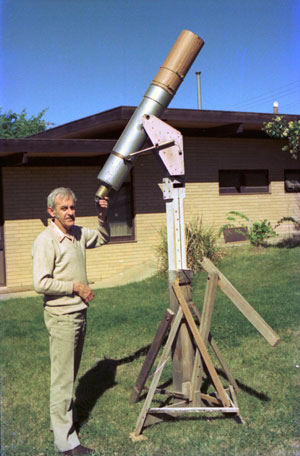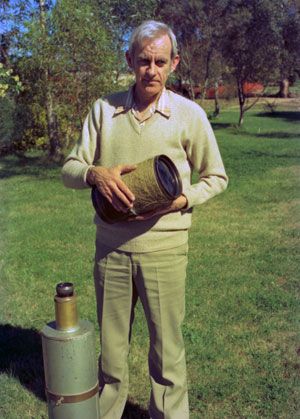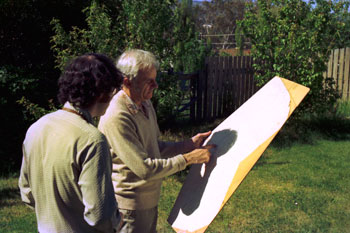Bill Bradfield, who passed away on June 9th, was one of the most prolific and elite comet discoverers of all time.

S&T: Dennis di Cicco
William A. Bradfield, the mild-mannered comet hunter of South Australia, died on June 9, 2014, at age 86. His remarkable tally of 18 comets, each discovered visually and credited to him alone, puts him among the most prolific and elite comet discoverers of all time.
Only the French observer Jean-Louis Pons (1761-1831) achieved more solo finds (22 comets) in his lifetime. The American amateur William R. Brooks (1844-1921), with 18 comets that were his alone, is the only other astronomer in the same league with Bradfield when it comes to visual discoveries.
Yet Bill Bradfield didn't even take up comet hunting until his mid-40s. Born in New Zealand in 1927, he moved to the outskirts of Adelaide, South Australia, in 1953, where he began his career as a rocket-propulsion engineer for the Australian Department of Defence. He was an amateur astronomer as well, but off and on. Then in 1970, when Comet Bennett vaulted into the predawn sky, it got him thinking, "Perhaps I can find a comet too."
By 1976 Bradfield was already a celebrity, having made six comet finds in as many years. That October, S&T's Dennis di Cicco and I visited him at his home in Dernancourt, a suburb about six miles northeast of Adelaide center. We'd arranged to arrive at 10 a.m., only to learn that he'd been up all night comet hunting! The telescope was still in the back of his stationwagon, and he gladly set it up for us.

S&T: Dennis di Cicco
We weren't quite prepared for the contraption we saw. He'd purchased it from Ralph Sangster, a fellow member of the Astronomical Society of South Australia, who had cobbled it together from unfinished boards and spare parts of every sort.
We soon realized, however, that this was a device superbly suited for finding comets. The giant Dallmeyer camera lens, made a century earlier for portrait photography, had an aperture of 6 inches. A war-surplus Erfle eyepiece provided 26x. With a 2-foot lever arm the instrument could be raised or lowered to let the observer stand comfortably at the eyepiece.
Then Bradfield did what he always did for visitors, letting us in on some of his secrets. He showed us a sinusoidal template that he could slide over his large star charts and plot, for reference, his own horizon at the start of morning twilight or the end of evening twilight. By flipping this template over, he could plot the horizon that observers in Japan would have the same night. The Japanese comet hunters were his fiercest competitors, and he'd always sweep areas of sky visible to them first. Only later would he leisurely return to the sky visible only from the Southern Hemisphere.
While none of his comets gave us the jaw-dropping spectacle of a Comet Bennett, West, or Hale-Bopp, several did reach naked-eye visibility. They've been of scientific interest, too. Spectra of C/1974 C1, taken at Wise Observatory in Israel, were among the first to show bands of ionized water in a comet. Ground-based instruments revealed C/1979 Y1 to be one of the gassiest comets ever, even though researchers using the International Ultraviolet Explorer satellite were puzzled not to find any trace of ionized carbon monoxide. A well-studied later Comet Bradfield, C/1987 P1, had an abnormally high dust-to-gas ratio.

S&T: Dennis di Cicco
Bradfield found his last comet in 2004, and it was his best. After it rounded the Sun (whose glare made it unobservable from the ground), C/2004 F4 entered the morning sky. As comet expert John Bortle (Stormville, New York) recalls, "For a week or so it remained an extraordinary sight, with a bright 3rd-magnitude starlike head and a very long, narrow, and wispy tail that could be traced for 12° or more."
None of Bradfield's 18 comets will return to the Sun's vicinity anytime soon. (That is, none were periodic in the technical sense.) We are not likely, either, to see another visual comet hunter as persistent, clever, and successful as Bill Bradfield.
NOTE ADDED 7/14/2014: Bill Bradfield talks about his search techniques and telescopes in this 6-minute video. (Thanks to Doug Zubenel and Martin McKenna for telling us about this.)
To read more about Bill Bradfield and his comet-seeking telescope, see the original article in Sky & Telescope published in April 1977.
 2
2









Comments
June 18, 2014 at 11:54 am
Roger,
It was a bit of a shock getting this news, not unlike when I heard of Leslie Peltier's passing back in 1980. I first corresponded with Bill briefly back in 1982, and I was inspired to build the type of alt-az mount he pictured in an article by Ben Mayer on p. 46 of the Jan. '82 issue of ASTRONOMY. Alan MacRobert imaged this mount and scope at the '87 TSP, and can be seen on p. 594 of the Dec. '87 S&T. I thought Bill invented this type of alt-az (and he may have, independently), but after seeing the old photo of the comet seeker mounting built by John Brashear in 1887, and pictured on p. 438 of the Apr. '91 S&T, I wonder if he knew of its existence.
I corresponded again with Bill in 2006, and had a pleasant conversation with him on the phone in March of that year, discussing the pros and cons of single-tube Newtonian binoculars.
It was a privilege to know and be inspired by you, Bill - rest among the comets!!
Regards,
Doug Z
You must be logged in to post a comment.
Hal Weaver
June 22, 2014 at 10:21 pm
I never met Bill Bradfield, but I'll always remember him fondly because my PhD thesis was largely based on an IUE investigation of one of "his" comets. As a grad student, I was fortunate to be able to point IUE at Comet C/1979 Y1 (then known as 1979 X) and use the results on OH, H, and O to argue that H2O was the dominant species in the coma (Weaver et al., ApJ, v251, pp 809-819, 1981). During a later re-analysis of the IUE data on this C/Bradfield, we were also able to measure the CO and CO2 abundances in the coma of this very "gassy" comet (Feldman et al., ApJ, v 475, pp 829-834, 1997). I'm sad to hear there will be no new comet Bradfields to study now.
Farewell to a great comet hunter,
Hal Weaver
You must be logged in to post a comment.
You must be logged in to post a comment.